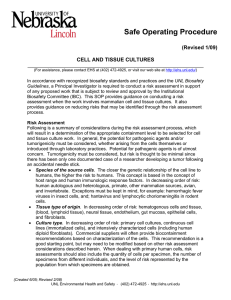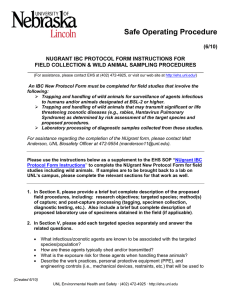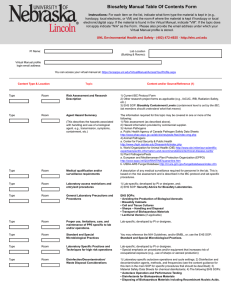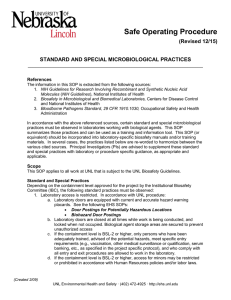Safe Operating Procedure (Revised 1/09) HIV AND HBV RESEARCH LABORATORIES/PRODUCTION FACILITIES
advertisement
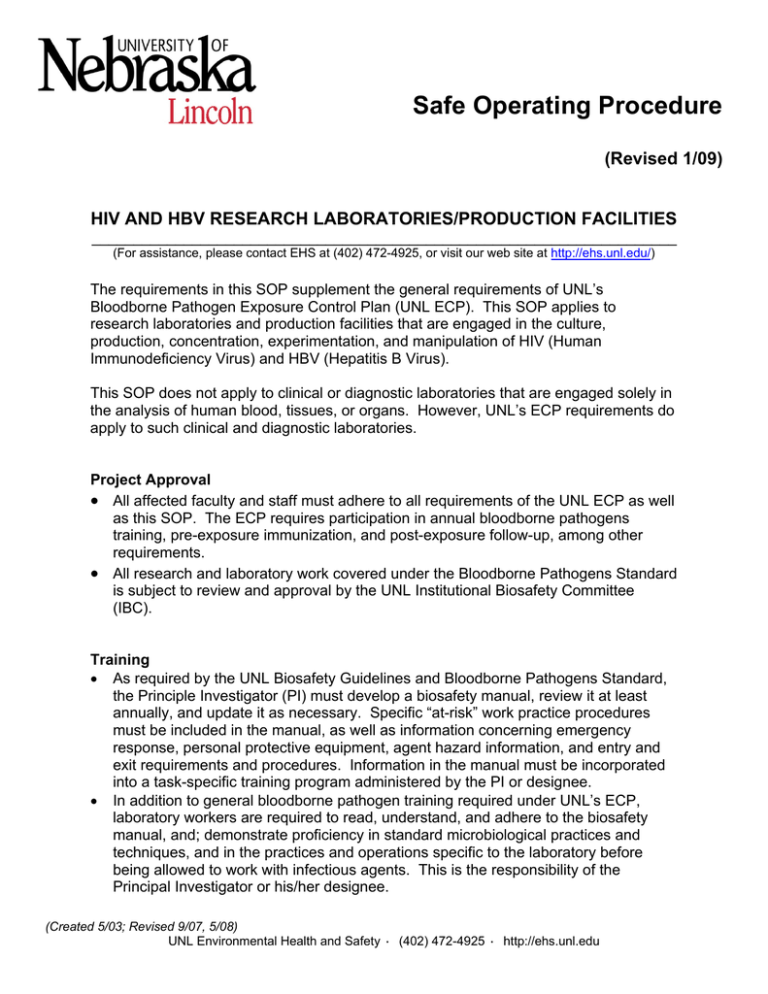
Safe Operating Procedure (Revised 1/09) HIV AND HBV RESEARCH LABORATORIES/PRODUCTION FACILITIES ______________________________________________________________________ (For assistance, please contact EHS at (402) 472-4925, or visit our web site at http://ehs.unl.edu/) The requirements in this SOP supplement the general requirements of UNL’s Bloodborne Pathogen Exposure Control Plan (UNL ECP). This SOP applies to research laboratories and production facilities that are engaged in the culture, production, concentration, experimentation, and manipulation of HIV (Human Immunodeficiency Virus) and HBV (Hepatitis B Virus). This SOP does not apply to clinical or diagnostic laboratories that are engaged solely in the analysis of human blood, tissues, or organs. However, UNL’s ECP requirements do apply to such clinical and diagnostic laboratories. Project Approval • All affected faculty and staff must adhere to all requirements of the UNL ECP as well as this SOP. The ECP requires participation in annual bloodborne pathogens training, pre-exposure immunization, and post-exposure follow-up, among other requirements. • All research and laboratory work covered under the Bloodborne Pathogens Standard is subject to review and approval by the UNL Institutional Biosafety Committee (IBC). Training • As required by the UNL Biosafety Guidelines and Bloodborne Pathogens Standard, the Principle Investigator (PI) must develop a biosafety manual, review it at least annually, and update it as necessary. Specific “at-risk” work practice procedures must be included in the manual, as well as information concerning emergency response, personal protective equipment, agent hazard information, and entry and exit requirements and procedures. Information in the manual must be incorporated into a task-specific training program administered by the PI or designee. • In addition to general bloodborne pathogen training required under UNL’s ECP, laboratory workers are required to read, understand, and adhere to the biosafety manual, and; demonstrate proficiency in standard microbiological practices and techniques, and in the practices and operations specific to the laboratory before being allowed to work with infectious agents. This is the responsibility of the Principal Investigator or his/her designee. (Created 5/03; Revised 9/07, 5/08) UNL Environmental Health and Safety · (402) 472-4925 · http://ehs.unl.edu Practices and Procedures • Entry and exit procedures and restrictions, as described in the biosafety manual, must be observed. • Procedures addressing accidental occupational exposure to bloodborne pathogens are described in the EHS SOP, On-The-Job Injuries. If nose, eyes, mucous membranes, or broken skin come in contact with potentially infectious material, flush these areas with water continuously for 15 minutes and seek immediate medical attention. Spills or accidents that result in potential exposure to bloodborne pathogens must be reported immediately to the PI and EHS. If the work also involves recombinant DNA, EHS may be required to file an incident report with the National Institutes of Health (NIH). • Hypodermic needles, syringes, and other sharp instruments may be used only when a safer alternate is not feasible. Only needle-locking syringes or disposable syringes with needle units that have a needle as an integral part of the syringe may be used for the injection or aspiration of potentially infectious material. Extreme caution must be used when handling needles and syringes in order to avoid self-inoculation and the generation of aerosols during use and disposal. A needle may not be bent, sheared, replaced in the sheath or guard, or removed from the syringe after use. The needle and syringe must be promptly placed in a rigid, leak proof, punctureresistant container and decontaminated, preferably by autoclaving, before being discarded or reused. The puncture-resistant container must be located as close to the work site as possible to minimize the distances the unprotected syringes and needles must be transported. See the EHS SOP, Sharps – Handling and Disposing. • Spills must immediately be contained and cleaned up by staff that are trained and equipped to work with potentially infectious material. See EHS SOP, Cleaning up Spills of Bloodborne Pathogens. Personal Protective Equipment • Laboratory, coats, gowns, smocks, uniforms, or other appropriate protective clothing must be used in the work area and animal rooms. Protective clothing may not be worn outside of the work area. See the EHS SOP, Handling Laundry Potentially Contaminated with Bloodborne Pathogens. • The appropriate combination of protective eyewear (goggles), masks, and/or a face shield must be worn when there is potential for a splash of potentially infectious material. Safety glasses are not appropriate eye protection to protect against liquid splashes and aerosols. • Protective gloves must be used when handling potentially infectious materials. Disposable gloves must not be washed or decontaminated for re-use; must be changed when known to be contaminated; and must be removed before leaving the laboratory. Hands must be washed thoroughly with soap and water after removing gloves and before leaving the laboratory. (Created 5/03; Revised 9/07, 5/08) UNL Environmental Health and Safety · (402) 472-4925 · http://ehs.unl.edu Facilities and Containment Equipment • Access to HIV and HBV laboratories must be restricted to authorized individuals. The PI is responsible for determining who is “authorized.” • Laboratory doors must be posted with biohazard and other appropriate warning signs and kept closed when work with HIV or HBV is in progress. Access doors to the work area or containment module must be self-closing. • The work areas must be separated from areas that are open to unrestricted traffic flow within the building. Passage through two sets of doors must be the basic requirement for entry into the work area from access corridors or other contiguous areas. Physical separation of the high-containment work area from access corridors or other areas or activities may also be provided by a double-doored clothes-change room (showers may be included), airlock, or other access facility that requires passing through two sets of doors before entering the work area. • An autoclave for decontamination of regulated waste must be available within or as near as possible to the work area. Autoclave(s) used for BBP decontamination should be enrolled in the EHS-administered autoclave performance testing program. • All aerosol-generating and open-container activities of potentially infectious materials must be conducted with appropriate containment (e.g., in a biological safety cabinet or other physical containment devices within a containment module). Such work must not be conducted on the open bench. If use of a biological safety cabinet is not feasible, the IBC may approve other appropriate control(s) (i.e., PPE, respirators, centrifuge safety cups, sealed centrifuge rotors, containment caging for animals, etc.). • Biological safety cabinets must be certified when installed, at least annually thereafter while in use, and when they are relocated, or there is reasonable cause to have them tested. Call the Facilities Management Service Desk at 472-1550 for assistance. • Vacuum lines must be protected with high-efficiency particulate air (HEPA) filters, or equivalent filters, and liquid disinfectant traps. Filters and traps must be checked routinely and maintained or replaced as necessary. • HIV and HBV research laboratories must be equipped with a sink for washing hands and an eye wash station. The sink must be designed for foot-, elbow-, or automatic operation and located near the exit door of the work area. • Interior surfaces of walls, floors, and ceilings must be water-resistant so that they can easily be cleaned. Penetrations in these surfaces must be sealed or capable of being sealed to facilitate decontamination of the work area. • A ducted exhaust air ventilation system must be provided. This system must create directional airflow that draws air into the work area through the entry area. The exhaust air must be discharged to the outside, and dispersed away from other occupied areas and air intakes. The proper direction of the airflow into the work area must be verified. (Created 5/03; Revised 9/07, 5/08) UNL Environmental Health and Safety · (402) 472-4925 · http://ehs.unl.edu Waste Disposal • All regulated waste must be autoclaved or decontaminated by another IBC-approved method prior to disposal. In the context of the Bloodborne Pathogens Standard, regulated waste means liquid or semi-liquid blood or other potentially infectious materials; contaminated items that would release blood or other potentially infectious materials in a liquid or semi-liquid state if compressed; items that are caked with dried blood or other potentially infectious materials and are capable of releasing these materials during handling; contaminated sharps; and pathological and microbiological wastes containing blood or other potentially infectious materials. • Contaminated materials that are to be decontaminated at a site away from the work area must be placed in durable, leak proof containers that are labeled (biohazard symbol) or colored red, and that are sealed before being removed from the work area. • As a good practice, waste rendered non-infectious by autoclaving should have a clearly visible indication of treatment (i.e., autoclave tape that turns colors upon autoclaving). (Created 5/03; Revised 9/07, 5/08) UNL Environmental Health and Safety · (402) 472-4925 · http://ehs.unl.edu
